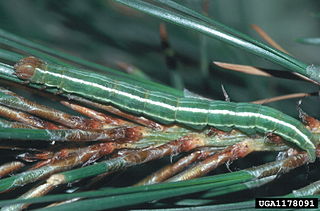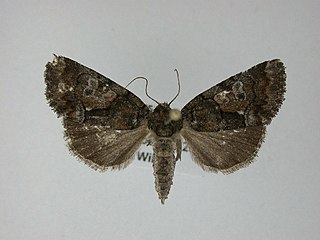
Citheronia regalis, the regal moth or royal walnut moth, is a North American moth in the family Saturniidae. The caterpillars are called hickory horned devils. The adult (imago) has a wingspan of 3.75–6.1 in (9.5–15.5 cm). The species was first described by Johan Christian Fabricius in 1793.

Hemaris gracilis, the slender clearwing or graceful clearwing, is a moth of the family Sphingidae. The species was first described by Augustus Radcliffe Grote and Coleman Townsend Robinson in 1865.

Eubaphe is a genus of moths in the family Geometridae erected by Jacob Hübner in 1823.
Abagrotis nefascia is a moth of the family Noctuidae first described by Smith in 1908. It is found in North America from Alberta and British Columbia down through Massachusetts to California. The species is listed as threatened in the US state of Connecticut.

Acronicta fragilis, the fragile dagger moth, is a moth of the family Noctuidae. The species was first described by Achille Guenée in 1852. It is found in North America from Newfoundland to Florida, west across Canada, south to Kentucky and Minnesota. It is listed as a species of special concern in the US state of Connecticut.

Annie Trumbull Slosson was an American author and entomologist. As a writer of fiction, Slosson was most noted for her short stories, written in the style of American literary regionalism, emphasizing the local color of New England. As an entomologist, Slosson is noted for identifying previously unknown species and for popularizing entomological aspects of natural history.

Eubaphe mendica, the beggar, is a moth of the family Geometridae. It was first described by Francis Walker in 1854 and it is found in eastern North America.

Zale curema, the black-eyed zale or northeastern pine zale, is a moth of the family Noctuidae. The species was first described by John Bernhard Smith in 1908. It is found from New York to Maine, south to western North Carolina, west to the Gulf States and Texas. The species is listed as endangered in Connecticut.
Drasteria occulta, the occult drasteria moth, is a moth of the family Erebidae. The species was first described by Henry Edwards in 1881. It is found in North America, where it has been recorded from coastal areas in Maine, New Jersey, Pennsylvania and Texas. It is listed as a species of special concern and believed extirpated in the US state of Connecticut.
Apodrepanulatrix liberaria, the New Jersey tea inchworm, is a moth in the family Geometridae. It was described by Francis Walker in 1860. It is found from extreme southern Quebec and southern Ontario southward into northern Florida and Mississippi. It is listed as endangered by state authorities in the US states of Massachusetts and Connecticut.

Chytonix sensilis, the barrens chytonix, is a species of moth of the family Noctuidae found in North America. It ranges from Quebec to Florida, and from Michigan to Texas. It was first described by Augustus Radcliffe Grote in 1881 and is now listed as endangered in the US state of Connecticut.
Papaipema leucostigma, the columbine borer, is a species of moth described by Thaddeus William Harris in 1841 and found in eastern North America. It is listed as endangered in the US state of Connecticut. The larvae feed on Aquilegia, common referred to as columbine.
Papaipema marginidens, the brick-red borer moth, is a species of moth found in North America. It was first described by Achille Guenée in 1852. It is found in eastern North America, from Pennsylvania and New York south to Georgia and North Carolina. It is now listed as endangered in the US state of Connecticut. The habitat consists of a mixture of open oak woodlands and barrens in rocky areas with herbaceous undergrowth- especially along streams.
Coranarta luteola is a moth of the family Noctuidae described by Augustus Radcliffe Grote and Coleman Townsend Robinson in 1865. It is found in the boreal zone of North America, from Alaska to Labrador. Its range extends south to Minnesota and Wisconsin in the Midwest and to Maine in the east. In the Rocky Mountains, it extends as far south as Colorado. It is listed as endangered in the US state of Connecticut.
Sympistis dentata, the toothed apharetra moth, is a moth of the family Noctuidae described by Augustus Radcliffe Grote in 1875. It is found from Yukon, the Northwest Territories, and British Columbia to Newfoundland and the northern United States, south in the east to New Jersey. It is listed as threatened in the US state of Connecticut.

Glena cognataria, the blueberry gray moth, is a moth native to North America. It ranges from Florida to Nova Scotia and New Brunswick. Its larvae are hosted on blueberry. The habitat consists of bogs and pine barrens. It is listed as a species of special concern and believed extirpated in the US state of Connecticut.

Dargida rubripennis, the pink streak, is a species of moth in the family Noctuidae. It was described by Augustus Radcliffe Grote and Coleman Townsend Robinson in 1870. It is found in the eastern United States, ranging to Kansas and Texas. It is listed as threatened in the US states of Massachusetts and Connecticut. The wingspan is 32–37 mm.
Eubaphe helveta is a species of moth in the family Geometridae first described by William Barnes in 1907. It is found in North America.

Eubaphe unicolor is a species of geometrid moth in the family Geometridae. It is found throughout North America to South America.
Eubaphe medea is a species of geometrid moth in the family Geometridae. It is found in Central America and North America.









